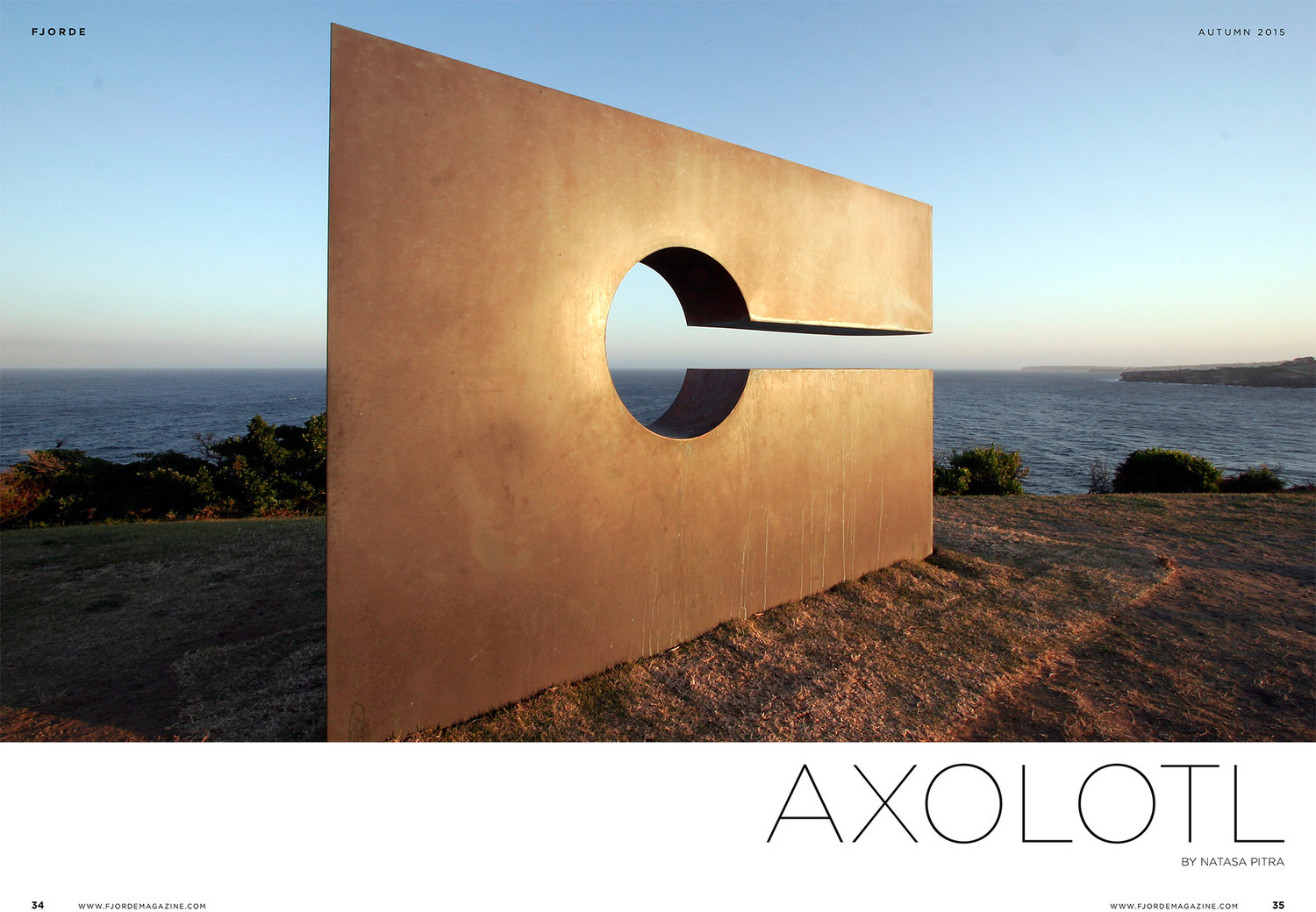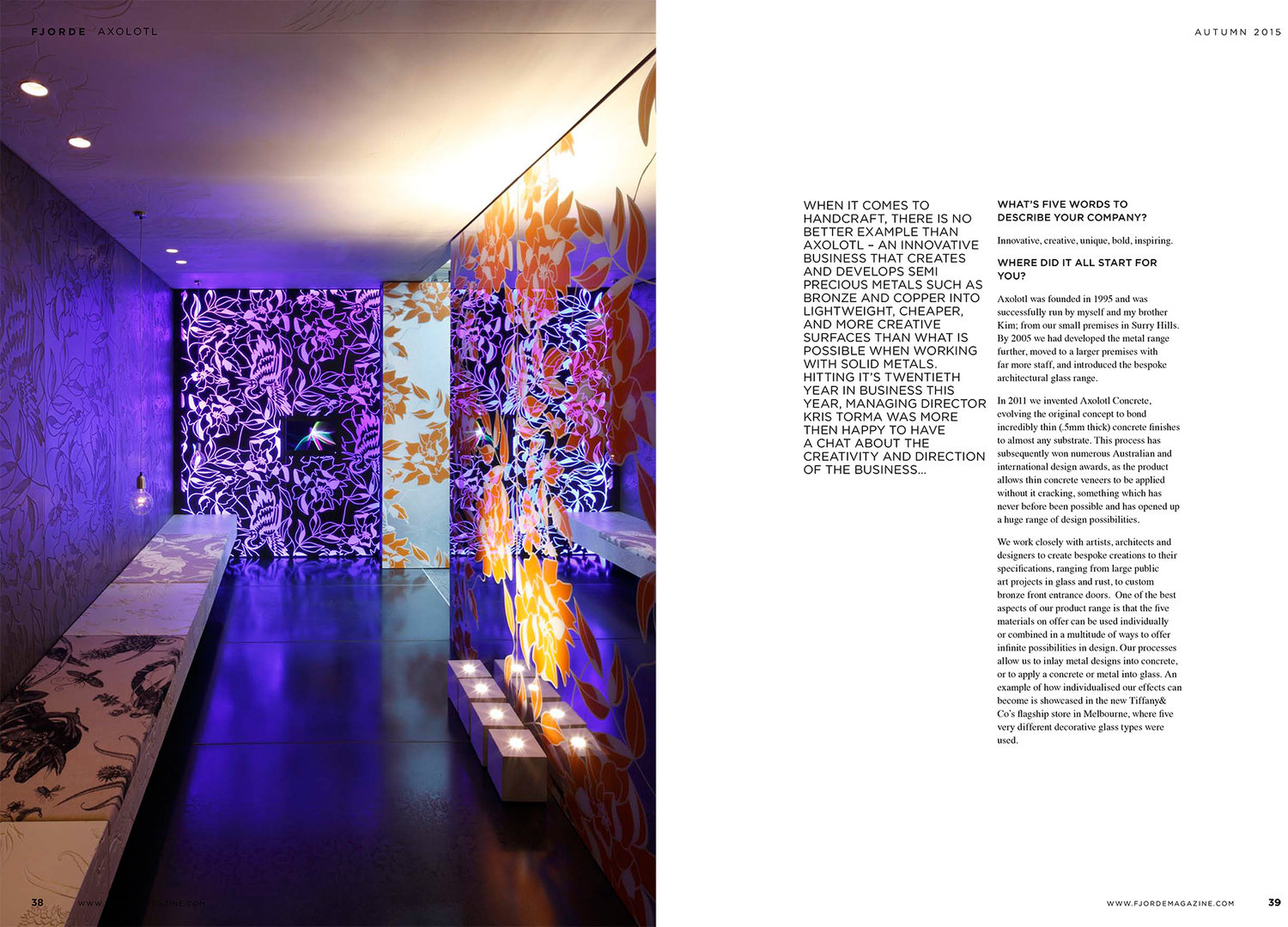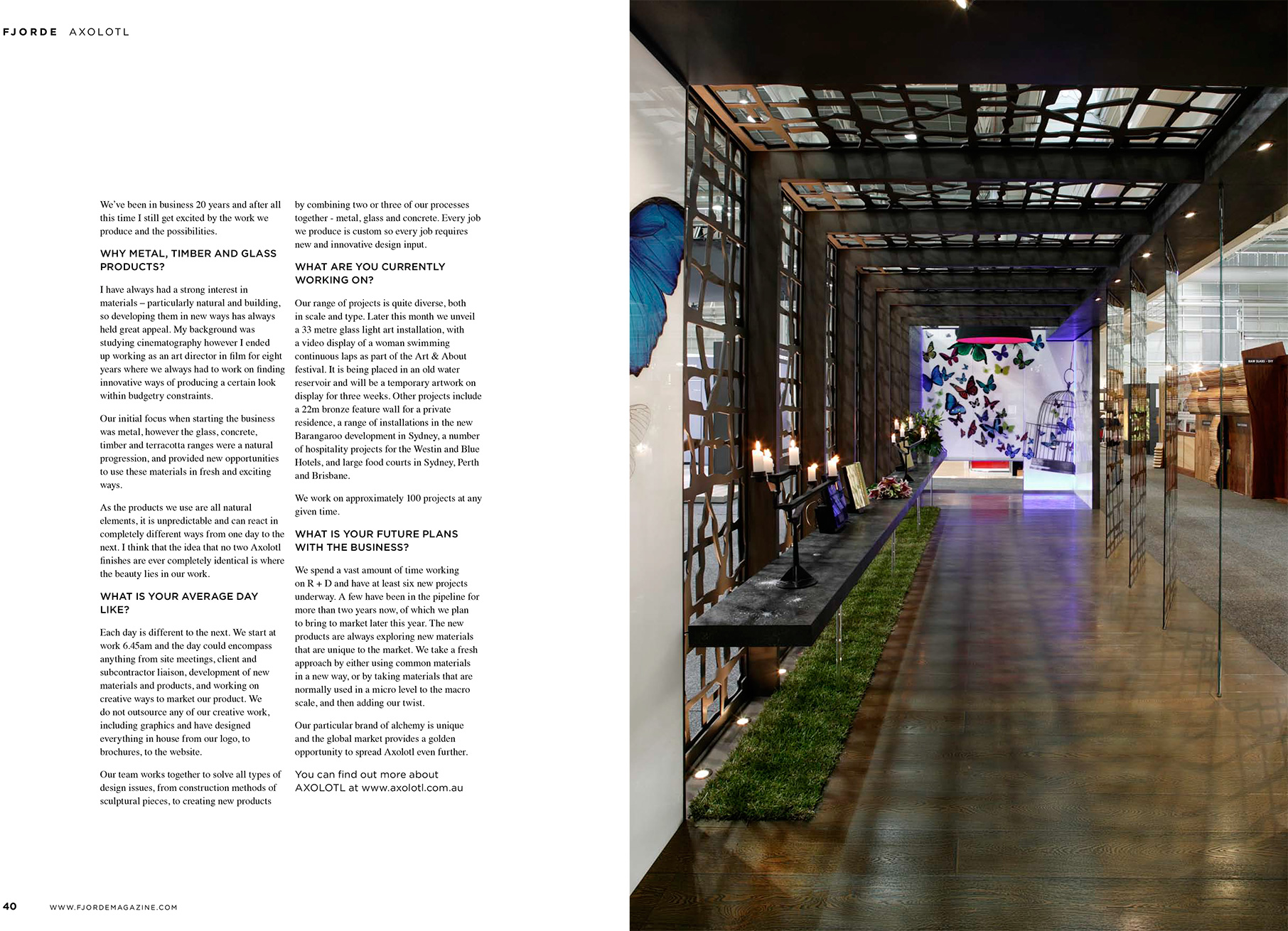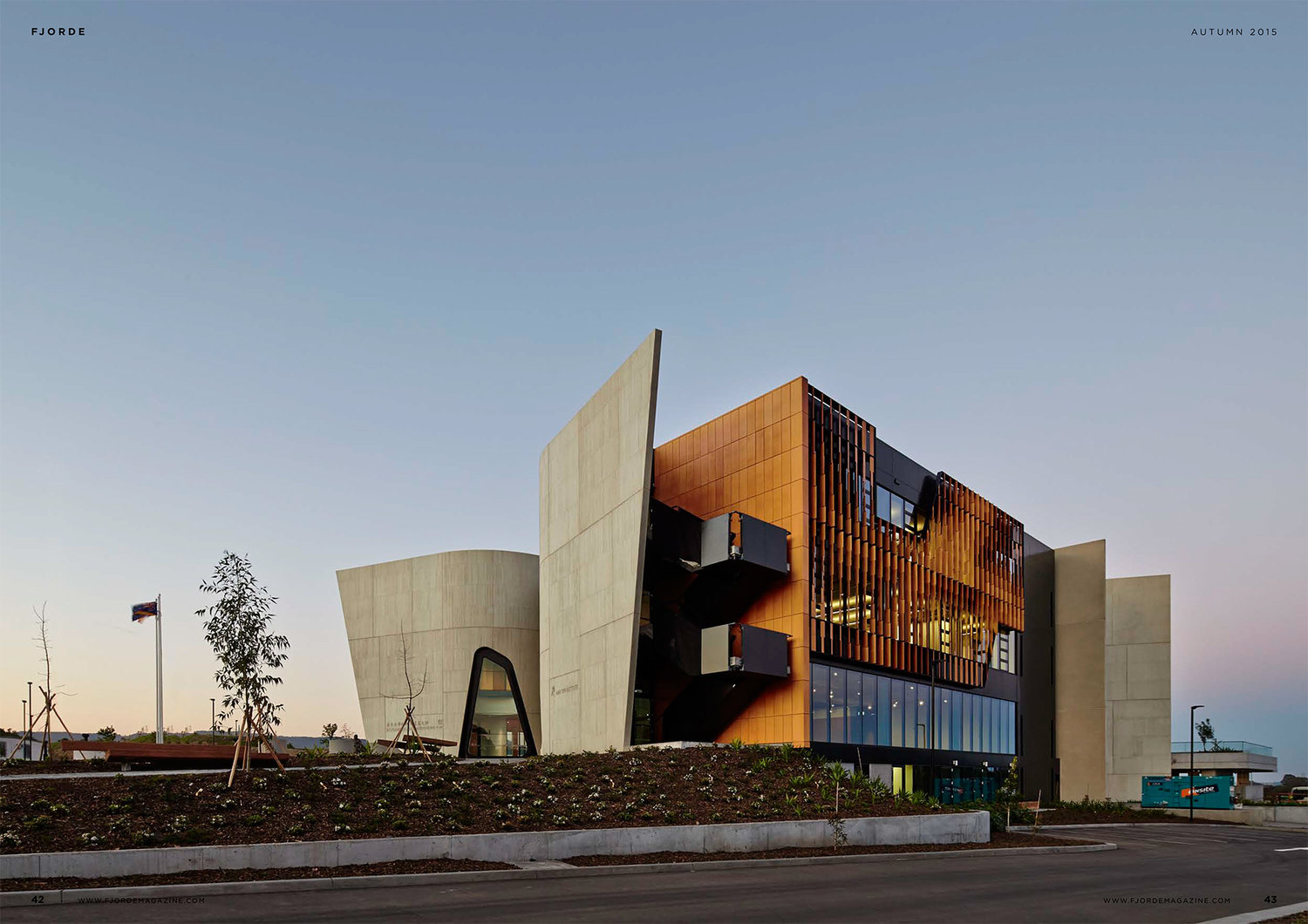MEDIA
Axolotl is proud to have been featured in over 500 magazines, radio and television as well as the recipients of more than 40 awards, including five international design awards.
A selection of the most current articles is below including a 20th anniversary celebratory article by Axolotl’s co-founder and Managing Director, Kris Torma.
Australian Financial Review
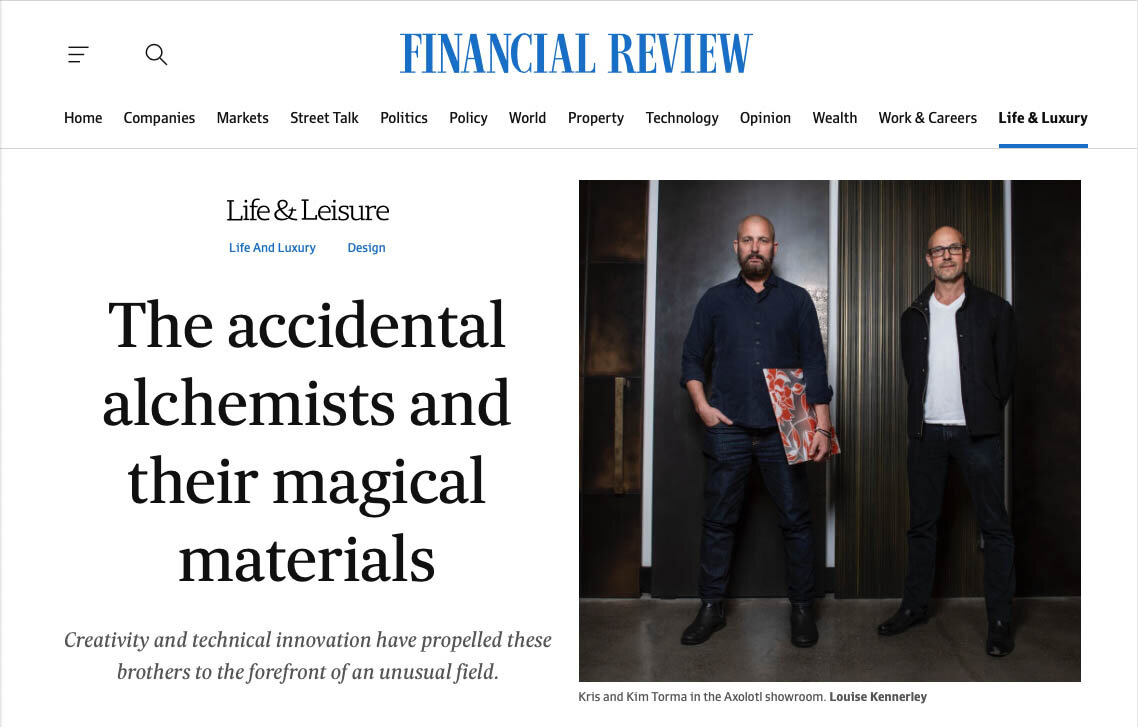
‘Right now it’s greys and silvers … nickel, zinc, pewter,” says Kris Torma. “Brass and copper go in and out of favour – they always come back. But bronze … well, bronze is forever.”
Torma and his brother know a little about trends. Back in 1995, their company, Axolotl, pioneered a technique for applying semi-precious metals to any surface, any size, any shape.
Because it is real metal, but only 0.5mm thick, an Axolotl surface can be polished, etched, combined with other materials and aged in days, not decades. Although it looks grand, it’s relatively cost-effective.
So it allows you to bestow the gravitas of Renaissance bronze on ordinary garage doors, or wrap a standard kitchen in the warm lustre of copper. The applications are immense, from trophies to whole buildings, and the company has won more than 40 awards for its work over its 25 years.
Axolotl grew out of a part-time picture framing business the Tormas had while working in other fields – Kris in cinematography and Kim in horticulture. Through trial and error they invented a way to achieve a metal look and feel on frames before testing their technique on entrance doors.
“People didn’t do metal doors before us,” says Kris, chatting in Axolotl’s office-showroom-factory in a southern Sydney industrial park. “They were too heavy, too hard to work with, too expensive.”
Axolotl still does 100 doors a year, ranging in price from $5000 to $60,000 plus, depending on size and complexity.
“This one,” he says, pointing to a handsome specimen, “was 3D-printed then bronze-coated, polished and aged. That one next to it was sandblasted first, then coated in aluminium.”
Hundreds of metal samples are displayed around the room like album covers in racks and on shelves. Some differences are obvious – colours from light to dark, textures rough to mirror-smooth. Others are incredibly subtle: there are, for example, 40 shades of rust.
“Actually,” says Kris, “it’s infinite.”
There are screens cut in Florence Broadhurst patterns and a stunning black marble coffee table incised with gleaming brass penstrokes. It’s by Spanish creative Jamie Hayon, one of the artists Axolotl paired up with for last year’s Easel Project (co-ordinated by Australian designers Adam Cornish and Marcus Piper).
Downstairs on the factory floor are more examples of Axolotl ingenuity: a scale model of a historic building that will become a touch-map for the blind; tubes of water inserted into lolly-coloured glass; a Mondrian-inspired glass door with graphite outlines awaiting colour panels.
Sydney’s CBD contains a fair representation of Axolotl’s work, from the glossy interiors of the Paspaley store and the lobby of the Westin hotel to the refurbished bronze doors, elevators and teller counters of Westpac’s old headquarters. For Melbourne’s Tiffany store, Axolotl reimagined the brand’s famous wheat leaf motif in silver, embedding it in jewel-like starphire glass.
The Tormas’ interest is in transforming materials, says Kris, “re-engineering them to take on new properties … lighter in weight, more flexible in form, or stronger than the original”.
Architecture firm Woods Bagot approached the brothers to see if they could make a terracotta façade for a project they were undertaking in Wollongong, the Nan Tien Institute. To make it out of solid ceramic would weaken the structure and add enormous weight. Axolotl found a way to apply a terracotta surface to aluminium blades, resulting in an earthy, surprising and sophisticated finish.
“We love nothing more than a brief that has no available solution, so we can create one,” Kris says.
Artist Jade Oakley is also at the factory, having a word with one of the designers (there are 25 employees on site as well as Kris’ dog and an office cat named Beatnik).
Oakley came to Axolotl in 2017, with an ambitious idea for a memorial wall at Harbord RSL Club: six giant copper poppies to float over a reflecting pool of water with a 35 square metre bronze wall behind, perforated by a sea of tiny lights. Oh, and the poppies needed to sway in the breeze.
From Oakley’s “little maquette made of cardboard and sticky tape”, Axolotl worked out the engineering specifications and co-ordinated the trades and processes involved in the installation.
It’s more than technical support that Axolotl offers Oakley. “I love bouncing ideas off people, and this place is one of my favourite trampolines,” she says.
Coming up for Axolotl – if it gets the go-ahead – are 25 shopfronts in 25 materials for Norman Foster’s Sydney Place project in the CBD. There will be more art, more experiments, more new materials. There will be trips, eventually, to the factories they have in the UK, Hong Kong, China, India and the US.
A blend of creative thinking and business management differentiates Axolotl from its competitors, and Kris says it springs in part from their upbringing.
“Our father was a sculptor and photographer and our mother was a ceramicist. We went to a Steiner school and many of our school friends went on to work in creative industries.
“Being entrepreneurial is probably also a family thing, as our father always worked in his own photographic business and we never saw ourselves in traditional desk jobs working for someone else.”
For Kris, constant innovation is not just a core part of the business, but stimulates the brothers to keep going. “We’re still developing new surfaces and designs on a regular basis, which is an incredibly creative outlet,” he says.
“Its been quite an exciting ride.”
INSIDE 94: PRACTICE

Text: Gillian Serisier
The brain-child of brothers Kris and Kim Torma, Axolotl, or as it was known then, Axolotl Metal Finishes, has come a long way since it first started transforming surfaces with lustrous layers of semi precious metal in 1995.
Now in its 21st year Axolotl has burgeoned into an international practice with factories operating in the UK, China, Hong Kong, and India. Closer to home a 1,100sqm factory and showroom provides the company headquarters in Matraville Sydney.
Interestingly, though a robust program of research and development went into Axolotl before they started their business, neither saw it as their primary career path. (Kris was a highly regarded and successful art director working in film and television while Kim was equally well regarded in his field of horticulture, while not hand building a mud-brick adobe house in Broke).
“The launch of Axolotl itself ended up being a pivotal moment in our business lives. It began almost as an experiment and we thought it would just be part time alongside our existing careers. However the reaction received for our metals was quite phenomenal and ultimately, we had to make the choice between pursuing separate careers or pursuing Axolotl” says Kris. But then they are no normal dabblers; rather, they are possibly the most driven and innovative pair working with surface technology today. And it is this aspect that has seen them steadily expand their offering from the original metal finishes, to concrete, glass and a soon to be launched paint range.
What makes them exceptional is a rare combination of a curious mind, excellent business sense and fearless experimentation: “Each product since inception has centred around using common materials and manufacturing processes in ways that really push the limits and haven’t been seen before. Our business is based on experimentation and not every venture eventuates – but the successes are truly bespoke” says Kris.
This coupled with an inherent ability to design, manifests as a unique formula of layered expertise. Where most would conquer a material simply by creating it, Axolotl see this as the starting point for evolution and innovation. The fact that they have the ability to work artistically with their own materials works in two ways, in that they are able to show application possibilities immediately, while having the requisite skills to deliver their client’s vision. Take their glass range for example, which they started manufacturing in 2005. “Glass was a key turning point for the business and seemed a natural progression of the Axolotl offer. Working with two materials gave us the opportunity to target the same clientele with a broader scope of materials and infinitely more design possibilities” says Kris. Not resting on their laurels, Axolotl have spent the intervening years innovating and developing glass processes that are recognised as unique in the world. In 2012, for example Axolotl Concrete and LINK were voted ‘Material of Excellence’ and selected for inclusion into the material archive by New York’s prestigious ‘Material ConneXion Resource Library’. And while each of their products is consistently recognised with awards, their most recent accolades include the 2015 ADEX Awards Platinum Award for Design Excellence’ for Axolotl Concrete and ‘Gold Award For Design Excellence’ for Axolotl Terracotta.
Key to the success of the product is the small amount of material needed to create a surface. Axolotl Concrete for example, as a surface finish uses 1.5% of the raw materials needed for a square meter of solid concrete (they are currently creating concrete blocks for a luxury yacht interior!). Metal finishes also use far less material and have the additional bonus of being 100% recycled. As such, while art projects have always been part of the Axolotl portfolio, it was not until they were invited to tender for a 520sqm feature wall for Hong Kong Airport in 2013 that they recognised both their talent and expertise to create and manage large-scale public art projects. Required to present a 6 x 6m section of art wall in Hong Kong as part of a competitive pitch against two other designs, the project used custom designed Axolotl glass and their inaugural use of computer synchronised lighting. “Whilst it was disappointing that we didn’t win, as the art piece was truly beautiful, it gave us the impetus to start Axolotl Art Projects. AAP now accounts for a large proportion of our work and really complements our core business” says Kris adding that the piece they created for artist Don Salisbury was recently awarded the 2015 Luminaire Design Award of Excellence for Light Sculpture and Installation.
At 20 plus years they could be forgiven a rest, but in true Axolotl form the showroom is brimming with new ideas and challenges to the way they use materials. Furniture, ceramics, art works, a motor cycle restoration, paint, concrete, glass and terracotta sit and merge with the original metal finishes in myriad incarnations, which, if the Tormas can find a way to do it (ie if it’s at all possible), will include paper by the end of the year. They are in fact an amazing Australian design manufacturing story and truly deserve all accolades.
Habitus Living Issue #29
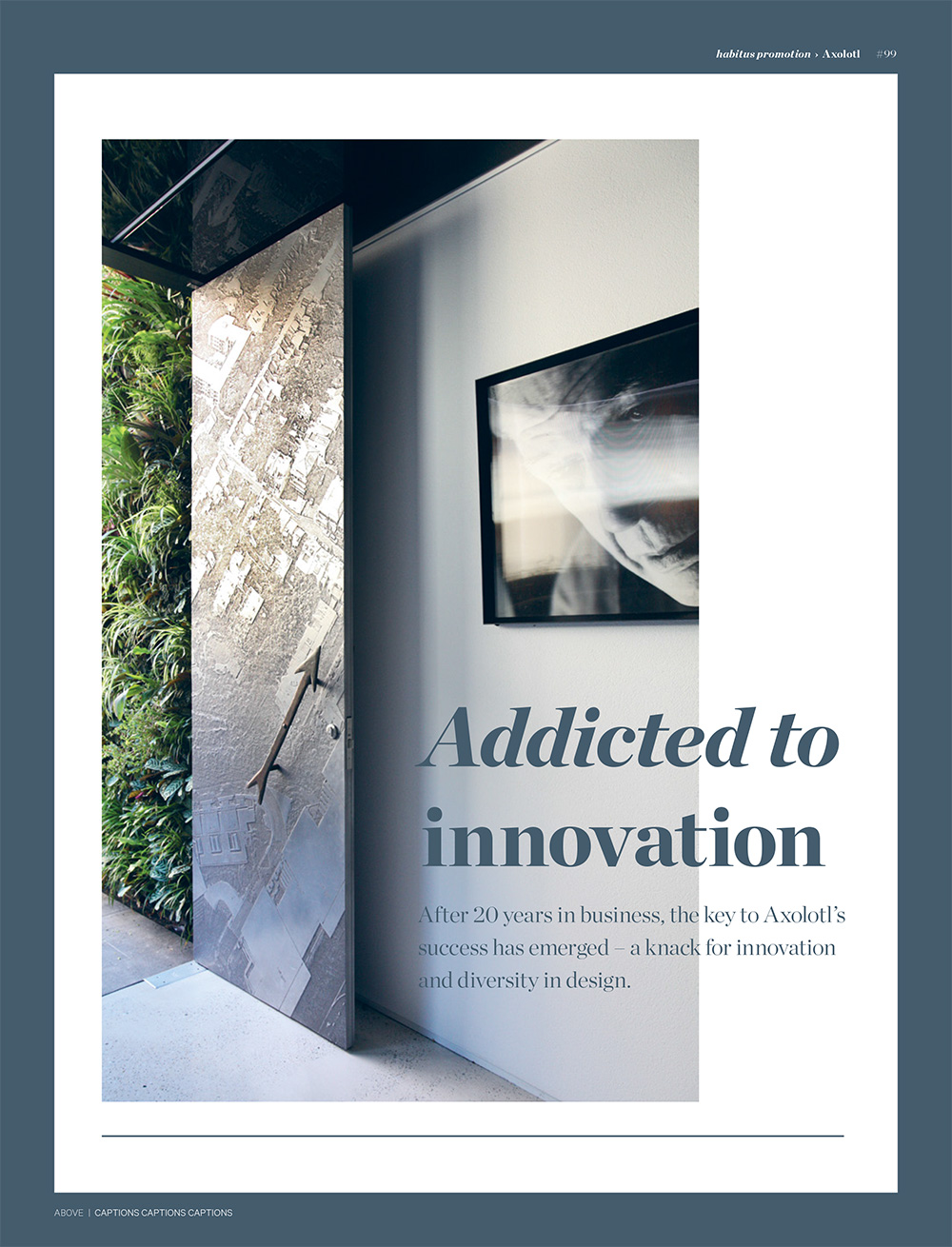
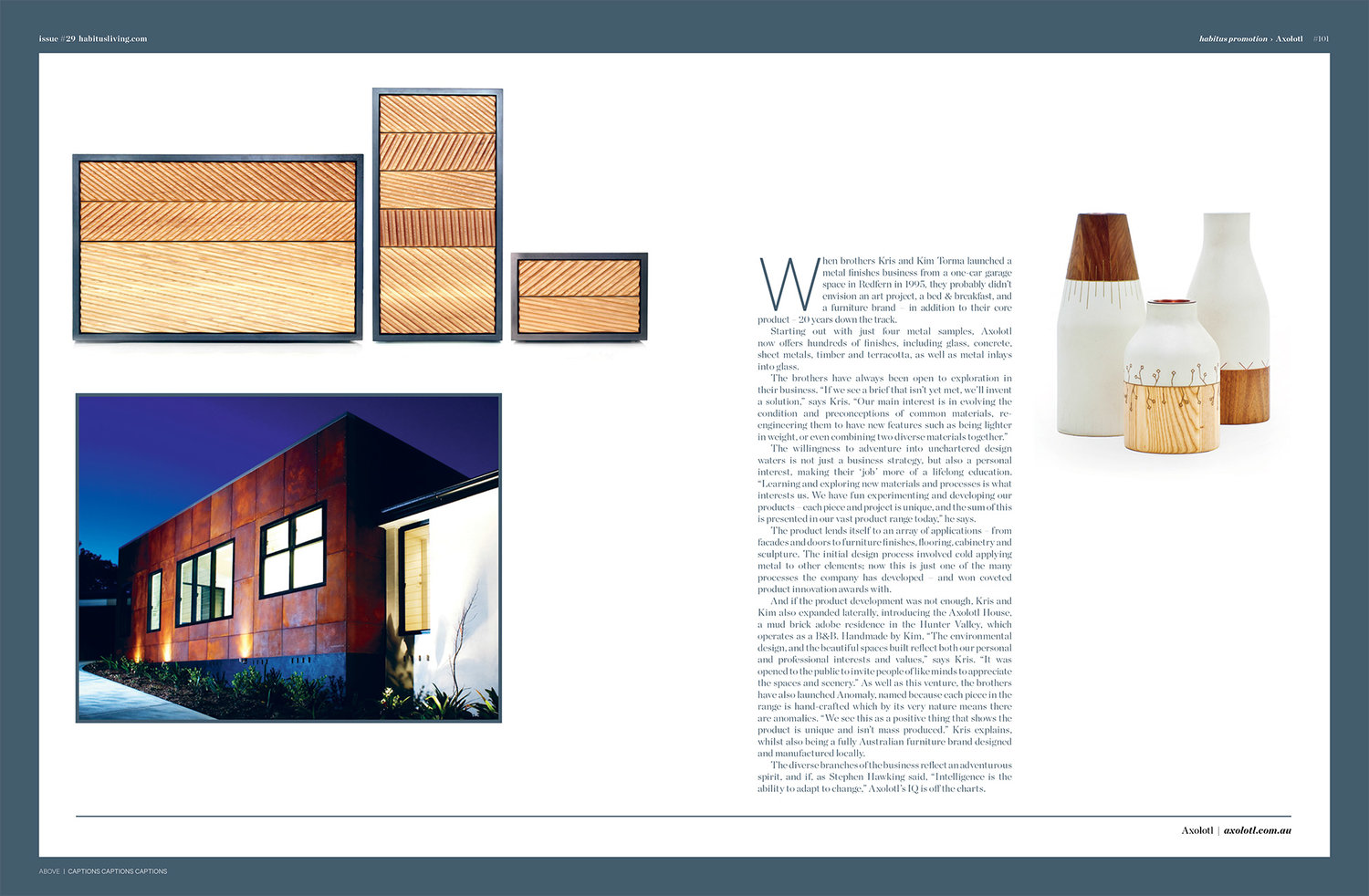
Addicted To Innovation
After 20 years in business, the key to Axolotl’s success has emerged – a knack for innovation and diversity in design.
When brothers Kris and Kim Torma launched a metal finishes business from a one-car garage space in Redfern in 1995, they probably didn’t envision an art project, a bed & breakfast and a furniture brand – in addition to their core product – 20 years down the track.
Starting out with just four metal samples, Axolotl now offer hundreds of finishes, including glass, concrete, sheet metals, timber and terracotta, as well as metal inlays into glass.
The brothers have always been open to exploration in their business, “If we see a brief that isn’t yet met, we’ll invent a solution.” Says Kris. “Our main interest is in evolving the condition and preconceptions of common materials, re-engineering them to have new features such as being lighter in weight, or even combining two diverse materials together.”
The willingness to adventure into unchartered design waters is not just a business strategy, but also a personal interest, making their ‘job’ more of a lifelong education. “Learning and exploring new materials and processes is what interests us. We have fun experimenting and developing our products – each piece and project is unique, and the sum of this is presented in our vast product range today,” he says.
The product lends itself to an array of applications – from facades and doors to furniture, finishes, flooring, cabinetry and sculpture. The initial design process involved cold applying metal to other elements: now this is just one of the many processes the company has developed – and won coveted product innovation awards with.
And if the product development was not enough, Kris and Kim also expanded laterally, introducing the Axolotl House, a mud brick adobe residence in the Hunter Valley, which operates as a B&B. Handmade by Kim. “The environmental design, and the beautiful spaces built reflect both our personal and professional interests and values,” says Kris. “It was opened to the public to invite people of like minds to appreciate the spaces and scenery.” As well as this venture, the brothers have also launched Anomaly, named because each piece in the range is hand-crafted which by its very nature means there are anomalies. “We see this as a positive thing that shows the product is unique and isn’t mass produced.” Kris explains, whilst also being a fully Australian furniture brand designed and manufactured locally.
The diverse branches of the business reflect an adventurous spirit, and if, as Steven Hawking said, “Intelligence is the ability to adapt to change.” Axolotl’s IQ is off the charts.
Innovative Household
At Australian company Axolotl, brothers Kris and Kim Torma have developed a seemingly impossible marriage – combining bespoke design with cutting-edge technology and, in the process, inspired designers and architects around the world with their must-have metal, glass and concrete products.
Tiffany & Co was so impressed with Australian metal, glass and concrete designer wunderkinds, Axolotl, that the internationally-renowned jeweller asked the company to craft a stunning entry facade for their new flagship store in Melbourne.
The result – a glowing, translucent sapphire glass border which surrounds an internal frit formed glass feature over two levels and mirrored balustrading, announces Axolotl has arrived, putting its stamp on sophistication in design and décor.
Axolotl has become the darling of designers and those craving greater levels of craftsmanship in their homes and workspaces.
Catering to our increasing desire to reflect our individuality and embrace cutting-edge materials, Axolotl has grown in only 16 years from inspiration to an operation employing 16 full-time staff and an international brand with licensees worldwide in Europe, Asia and the Middle East.
The company was started by brothers Kris and Kim Torma, after years of research and development in metal technologies, as a small operation run out of a warehouse in the backstreets of Sydney’s Redfern in 1995.
Kris’s background prior to being at the helm of the Axolotl juggernaut as Managing Director, was in film and television set design and cinematography. His design background and experience allowed him to identify an untapped niche in the market – a need for solid metal aesthetic without the associated restrictions such as weight, cost and availability.
Collaborating with brother and artist Kim as Creative Director, who brought his practical knowledge, hands-on experience and creative drive to the table, Axolotl was born.
The name “Axolotl” was chosen, according to Kris, as “we wanted the name and brand to be able to stand alone. “We also wanted the company name to be free from the constraints of being a one product company as we knew the company had the potential to evolve to encompass other innovative products and ventures, which it has with glass and concrete.”
Using the proprietary technology, Axolotl has developed techniques which enable designers to fuse metal into glass, concrete into glass and metal into concrete.
“In fact, all three surfaces can now be used together to create virtually anything at all,” says Kris.
Kris believes that metal is a natural element and sits perfectly incorporated into Australian residential design “whether it be a façade of richly-coloured Axolotl orange rust or aged copper, bronze or zinc.
“Australia has an incredibly harsh climate. It is testament to the durability of Axolotl products that after 16 years in our harsh environment, Axolotl coatings look as good today as they did when they first came out of the factory.”
Kris and Kim can proudly describe their work as “bespoke”: “Everything we do is completely custom-made and hand-finished; we don’t stock any off the shelf products,” says Kris. “As metal is a natural element, it is unpredictable and can react in completely different ways from one day to the next. I think that is where the beauty lies in our finishes, the idea that no two Axolotl finishes are never completely identical.
“Every job that is undertaken is a true one-off, from creating a copper front entrance door to bronze screens, carved glass balustrades and concrete furniture.”
Inspiration comes from many places, says Kris – and some of Australia’s most talented artists, architects and interior designers often come to Axolotl with their idea of what they want to create – “We find a way to make it happen”.
Axolotl’s work can be seen on feature walls, garage doors, front doors, gates, in kitchens, bathrooms, on stairs and counters.
Some well-known locations include Sydney International Airport which features Axolotl Metal on shopfronts throughout and the Sydney Opera House with feature pieces in the prestigious Guillame at Bennelong restaurant
Kris’s favourite works
“Rouse Hill Food Court in the new Rouse Hill development is a favourite – designed by Philip Chia, it features over 1,000 square metres of rusted screens, beams and door frames. The same design was even incorporated into the glass. It was a very brave design and it works wonderfully.
“The sculptural work we produce is also a favourite – Artists including Mark McClelland (winner Sculpture by the Sea in 2008 using Axolotl bronze), Jane Cavanough always pushes the boundaries with our products and Janet Laurence’s work is just exquisite.”
Tiffany’s flagship store was created after collaboration with New York architects and designers. Five totally custom-made works of art in glass also feature in the store.
“We’re currently working on totally new designs for their new shop in Sydney and have been asked to produce work for one of their stores in Mexico City,” Kris proudly says.
Audrey Hepburn would also be proud.
JUDY FRIEDLANDER
AXOLOTL
BY NATASHA PITRA
WHEN IT COMES TO HANDCRAFT, THERE IS NO BETTER EXAMPLE THAN AXOLOTL – AN INNOVATIVE BUSINESS THAT CREATES AND DEVELOPS SEMI PRECIOUS METALS SUCH AS BRONZE AND COPPER INTO LIGHTWEIGHT, CHEAPER, AND MORE CREATIVE SURFACES THAN WHAT IS POSSIBLE WHEN WORKING WITH SOLID METALS. HITTING ITS TWENTIETH YEAR IN BUSINESS THIS YEAR, MANAGING DIRECTOR KRIS TORMA WAS MORE THEN HAPPY TO HAVE A CHAT ABOUT THE CREATIVITY AND DIRECTION OF THE BUSINESS…
WHAT’S FIVE WORDS TO DESCRIBE YOUR COMPANY?
Innovative, creative, unique, bold, inspiring.
WHERE DID IT ALL START FOR YOU?
Axolotl was founded in 1995 and was successfully run by myself and my brother Kim; from our small premises in Surry Hills. By 2005 we had developed the metal range further, moved to a larger premises with far more staff, and introduced the bespoke architectural glass range.
In 2011 we invented Axolotl Concrete, evolving the original concept to bond incredibly thin (.5mm thick) concrete finishes to almost any substrate. This process has subsequently won numerous Australian and international design awards, as the product allows thin concrete veneers to be applied without it cracking, something which has never been possible and has opened up a huge range of design possibilities.
We work closely with artists, architects and designers to create bespoke creations to their specifications, ranging from large public art projects in glass and rust, to custom bronze front entrance doors. One of the best aspects of our product range is that the five materials on offer can be used individually or combined in a multitude of ways to offer infinite possibilities in design. Our processes allow us to inlay metal designs into concrete, or to apply a concrete or metal into glass. An example of how individualised our effects can become is showcased in the new Tiffany & Co’s flagship store in Melbourne, where five very different decorative glass types were used.
We’ve been in business 20 years and after all this time I still get excited by the work we produce and the possibilities.
WHY METAL, TIMBER AND GLASS PRODUCTS?
I have always had a strong interest in materials – particularly natural and building, so developing them in new ways has always held great appeal. My background was studying cinematography however I ended up working as an art director in film for eight years where we always had to work on finding innovative ways of producing a certain look within budgetary constraints.
Our initial focus when starting the business was metal, however the glass, concrete, timber and terracotta ranges were a natural progression, and provided new opportunities to use these materials in fresh and exciting ways.
As the products we use are all natural elements, it is unpredictable and can react in completely different ways from one day to the next. I think that the idea that no two Axolotl finishes are ever completely identical is where the beauty lies in our work.
WHAT IS YOUR AVERAGE DAY LIKE?
Each day is different to the next. We start at work 6:45am and the day could encompass anything from site meetings, client and subcontractor liaison, development of new materials and products, and working on creative ways to market our product. We do not outsource any of our creative work, including graphics and have designed everything in house from our logo, to brochures, to the website.
Our team works together to solve all types of design issues, from construction methods of sculptural pieces, to creating new products by combining two or three of our processes together – metal, glass and concrete. Every job we produce is custom so every job requires new and innovative design input.
WHAT ARE YOU CURRENTLY WORKING ON?
Our range of projects is quite diverse, both in scale and type. Later this month we unveil a 33 metre glass light art installation, with a video display of a women swimming continuous laps as part of the Art & About festival. It is being placed in an old water reservoir and will be temporary artwork on display for three weeks. Other projects include a 22m bronze feature wall for a private residence, a range of installations in the new Barangaroo development in Sydney, a number of hospitality projects for the Westin and Blue Hotels, and large food courts in Sydney, Perth and Brisbane.
We work on approximately 100 projects at any given time.
WHAT IS YOUR FUTURE PLANS WITH THE BUSINESS?
We spend a vast amount of time working on R + D and have at least six new projects underway. A few have been in the pipeline for more than two years now, of which we plan to bring to market later this year. The new products are always exploring new materials that are unique to the market. We take a fresh approach by either using common materials in a new way, or by taking materials that are normally used in a micro level to the macro scale, and then adding our twist.
Our particular brand of alchemy is unique and the global market provides a golden opportunity to spread Axolotl even further.
You can find out more about AXOLOTL at www.axolotl.com.au
H + G
How was Axolotl founded? What inspired the company – and the name?
My brother Kim and I started the company in 1995. The idea of a liquid metal surface treatment came about while running a part time picture framing business and seeing a demand for semiprecious metal frames. And after years of research and testing into how to work with and apply real metals to lighter substrates the Axolotl metal surface coating technology was created.
Considering my background was in film and television set design, and Kim’s in horticulture it seems an unusual segue to move into metal finishes – however the opportunity to work closely with one another was exciting, and after some market research we saw real architectural potential for our product and decided to concentrate on the company full time.
Collaborating with Kim was natural, he added practical know-how and the same love of design to the partnership. We started as a small two person operation running out of a tiny space in the backstreets of Sydney’s Redfern, and moved into larger spaces as we grew.
The name “Axolotl” was chosen as we wanted the business name to be unique, and sound intriguing enough that people would want to know more. Not choosing a name that related to metal, or veneers was intentional. We also wanted the company name to be free from the constraints of being a one product company as we knew the company had the potential to evolve and encompass other innovative products and ventures, which it has done with glass and concrete over the years.
Where was the first showroom?
Our first showroom was in Redfern – a 40sqm space above a one car garage where we produced all our work.
What did Axolotl set out to achieve upon starting?
Axolotl was born out of an idea to apply semi precious metals such as bronze and copper onto lightweight, cheaper, and more creative surfaces than what is possible when working with solid metals. We saw our metal surfaces having a range of applications such as framing, signage and wherever metal would look great but was handicapped by weight, size or cost. As we established the business we saw a lot of interest coming out of the architectural sector, particularly architects and designers looking for more cost effective and flexible ways to incorporate metals into internal and external designs. The Axolotl brand quickly grew a positive reputation in the industry and forged strong relationships with architects, designers and builders, cementing the direction of the Axolotl product range within the architecture sector.
We decided to complement the range with bespoke architectural glass, through the purchase of Ozone Glass in 2005, subsequently renamed Axolotl Glass. Our new glass procedures were rolled under the Axolotl umbrella and continues to be one of our core products. In 2011 we set out to apply our technology to other surfaces, launching Axolotl Concrete and Terracotta. This development allowed thin concrete veneers to be applied without cracking, to lightweight building materials and opened up a huge range of design possibilities. These surfaces were well received, winning numerous Australian and international design awards including being showcased at the Powerhouse museum for twelve months.
Over the years we have continued to approach common materials in innovative ways, combining surfaces and techniques that hadn’t been considered before such as inlaying metal into stone and concrete into glass.
What are the core values and goals of the Axolotl?
If we see a brief that has no available solution then we will create one. Our main interest is in usurping the restraints and preconceptions of common materials, re-engineering them to take on new properties – such as being lighter in weight, flexible in form, or stronger than the original.
The willingness to venture into unchartered design waters is not just a business strategy, honestly it often takes more than it gives financially, it stems from our passion for beauty and our enjoyment of being creatively challenged.
This has been a big driver in developing AAP, our art projects division over the past two years. AAP allows us to work directly with artists, helping to develop their ideas in new mediums, or designed for public settings. We were incredibly excited and honoured to be a Supporting Partner of Sculpture by the Sea in Bondi in 2017 and have just re-committed to sponsoring the event in 2018.
Axolotl is now a successful company – were there any obstacles that had to be overcome to get to this point?
So many. In offering a highly bespoke product and working with natural materials, every piece we produce is custom and we have had to carefully market our brand and materials in this way. There is an expectation for architectural suppliers to have stock ready, to produce very consistent products, and to be automated. We have spent a lot of time developing our processes to be as efficient, and consistent in the effects we achieve as possible, and this has become a valuable asset both for our head factory in Sydney and our newer factories operating around the world in securing work and maintaining profitability.
What are 2 or 3 of the highlights from Axolotl’s history?
Expanding internationally.
Expanding our product range from two materials to nine in just five years.
Winning 40 awards over 20 years
Recognition for innovation and hard work by artists, architects and interior designers.
In your own words, can you describe the style and vibe of Axolotl as a company?
Our showroom is the best way to experience Axolotl – visitors often comment on being impressed by the range and the originality of ideas and materials that we create. They also get to meet our team in a (pet friendly) relaxed studio environment, where we are ready to discuss their brief.
What do you hope to achieve in the future?
We have always invested a huge amount of time working on R + D and have at least six new projects underway. A few have been in the pipeline for more than two years now, with plans to bring to market later this year. The new products are always exploring new materials which are unique to the market. We try to take a fresh approach by either using common materials in a new way, or by taking materials that are normally used in a micro level to the macro scale.
We have recently purchased a 3D flatbed printer where we can now 3D print any design up to 2400 x 1600mm. This has opened up a whole new range of design possibilities as we are now no longer restricted by intricate surfaces – any design can be realised in just about any surface. We plan to continue to invest our time into exploring the possibilities of this technology and hope to develop some more phenomenal surface effects.
We would also love to create a more standardised, off the shelf product to reach a broader market in the future. In search of this we have produced furniture pieces with success in collaboration with some amazing talent over the years, including designers such as Matthew Sheargold and David Caon. Recently we have been working on a marketing exercise with Mark Tuckey and Caroma to show how Axolotl finishes can be incorporated into bathrooms with an affordable budget. Our factory in China is also working with a prominent European bathware supplier to produce a range of products.
Axolotl Paint is also a part of this product strategy, with a set range of finishes and colours available to purchase off the shelf. However it’s early days for Axolotl Paint and our marketing focus at this stage is still architects and designers as we simply don’t have the budget to take on Dulux and the like with the broader public market.
Finally, AAP is a dedicated division set up to support artists and fabrication of their works. It is a very personal love affair for Kim and I as both our parents were artists – our father was a photographer and sculptor and mother was a ceramicist. Over the past two years AAP has worked with a growing number of artists and projects, and we would love to see this part our company continue to expand.
What are Axolotl’s most iconic products and why?
Our semi precious metal application would be the most iconic, it was the material that started the business and the one that we have perfected over the past 23 years.
When the company first started, how many employees were there? And now?
The company started with just Kim and I. today there are over 100 employees working in Axolotl facilities worldwide.
Can you tell me the locations of your current showrooms?
Our factories and showrooms are located in Sydney, Perth, London, Florida, Hong Kong, China and India.
The head office is Sydney is at 6/73 Beauchamp Rd, Matraville and we are open Monday to Friday. We have four designers in the showroom who can assist anyone, although we do recommend making an appointment if you would like to spend more time going through the surfaces and ideas. We also have two colour consultants who work with Axolotl Paint who are available for on-site colour consultations.
20 years and still innovating
In July 1995 my brother Kim and I launched Axolotl from a one-car garage space in Redfern. This month marks our 20th anniversary and to celebrate we wanted to share our story, and to thank all of those who have been involved.
From humble beginnings, booking presentations with architects and designers to showcase our four metal samples (available in a single texture!), we have long outgrown our garage. Our transition, from simple pioneers of a process that involved cold applying metal to other elements, to our current range of products and processes that extend way beyond metal as a material, have garnered recognition and reward on an international scale.
Ten years after we first set up shop, glass was added to our product range and working with two materials now opened up even greater design possibilities. We pioneered LINK, which enabled metal to be inlaid into glass and won us a coveted product innovation award.
We then survived the double hit of the GFC in 2009 and the realisation that we had been embezzled by a manager in the business, reducing our staff of 32 to 13. With lean times and support from our suppliers and staff we were able to survive the ensuing years.
As is often the case, out of austerity came creation and those lean times saw Axolotl launch concrete, sheet metals, timber and terracotta surfaces into our range. Once again we offered design innovators the potential to challenge and author the type of new concepts that drive them.
In a somewhat lateral skew, Axolotl House, a sustainable mud brick home built by Kim was opened in the Hunter Valley as a B&B – a true shrine to quality craftsmanship.
And in 2013, we continued to flex our design muscle, creating furniture brand Anomaly in partnership with Evostyle. Boasting an all-Australian made furniture range designed by some of Australia’s top designers.
Our latest offer, Axolotl Art Projects, promises a new resource for artists, developers and local governments to not only project manage art projects but to fabricate them. Since 2014 when this was first launched, we have already been awarded high profile and blue chip projects.
Looking back, we are grateful to realise that we have been featured in over 500 magazines, on radio, television and have been the recipients of more than 40 awards, including five international design awards. Our range of four metals has multiplied to hundreds and our products have been featured on buildings worldwide. We have worked with imaginative and visionary people including artists, architects and interior designers who we can’t thank enough for their ongoing support, and their continuing push for us to turn their 2D plans into 3D reality.
But it’s more than just products, it’s personal. Our staff are now an extended family. We have incredibly low turnover rates, which is great as they are so talented we never want them to leave.
Looking to the future we have, as always, a number of new product developments underway. Nothing we can giveaway yet, but keep a look out at the four grey empty boxes on the Products page on our website, as they get filled with new innovative products over the coming months.
Of course, no business should be in business without a commitment to minimising their environmental footprint. By the end of August we will have installed a 50kW solar panel system on the roof of our factory, the equivalent of 1000sqm of solar panels, which is expected to at least meet, if not possibly surpass, our monthly power requirements.
It’s true that what started out as a small metal bonding business has grown way beyond our expectations back in 1995, but innovation has always been at the heart of the Axolotl brand and this passion to offer new possibilities has not abated with time. Axolotl has always, and will always, transcend the idea of a simple product or manufacturing business.
So, as we move forward, redefining possibilities in the built environment for another 20 years, we would like to thank everyone who has ever been involved with the business, your presence and positivity has greatly shaped us. With your continued support and inspiration we can only promise to try to live up to our past, in the future.
Kris Torma

